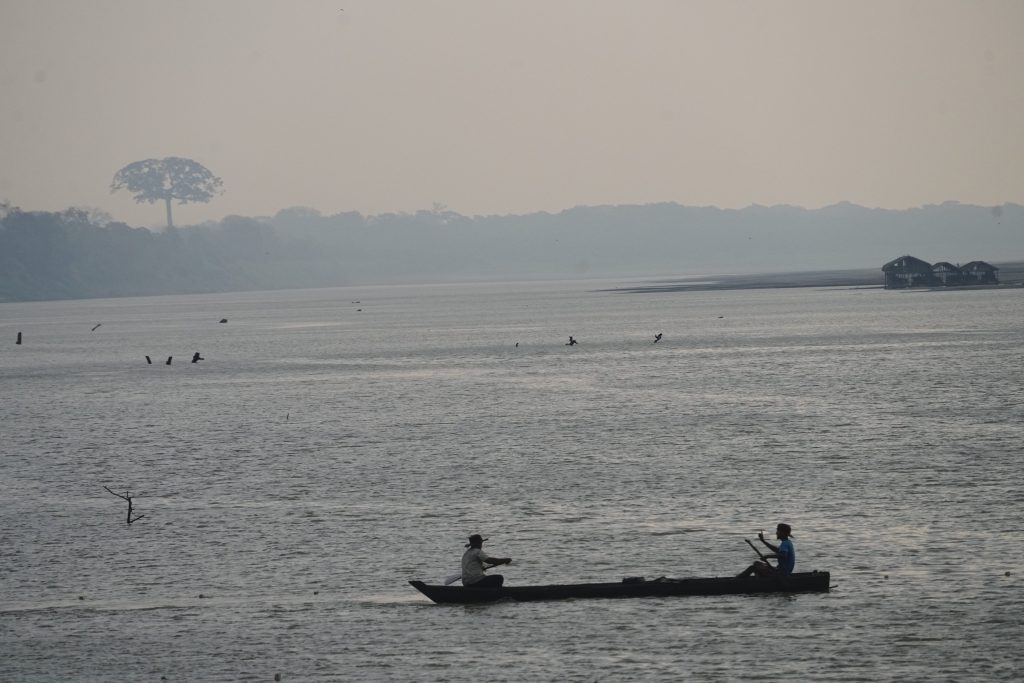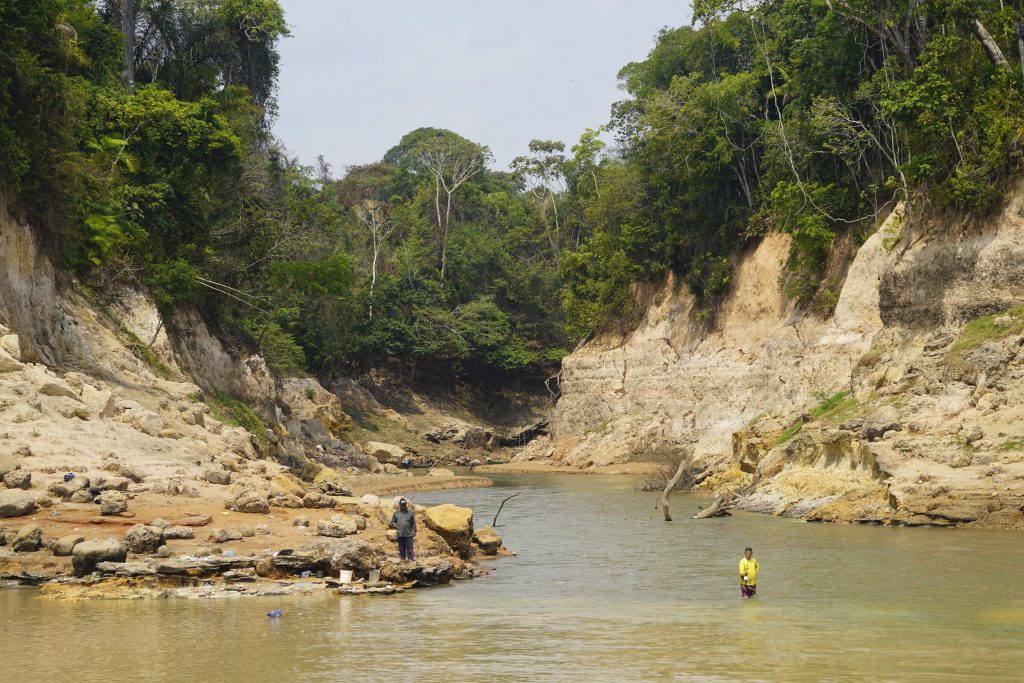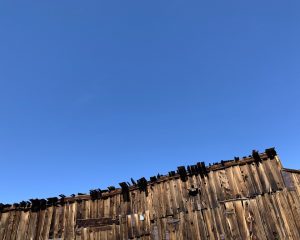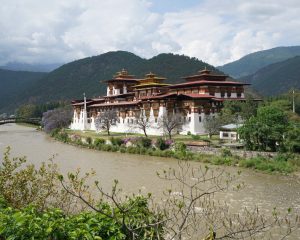This month, I went to the Amazon to do reporting for the book I’m writing about giant fish, but the fires raging across the Amazon basin made for a change of plans.
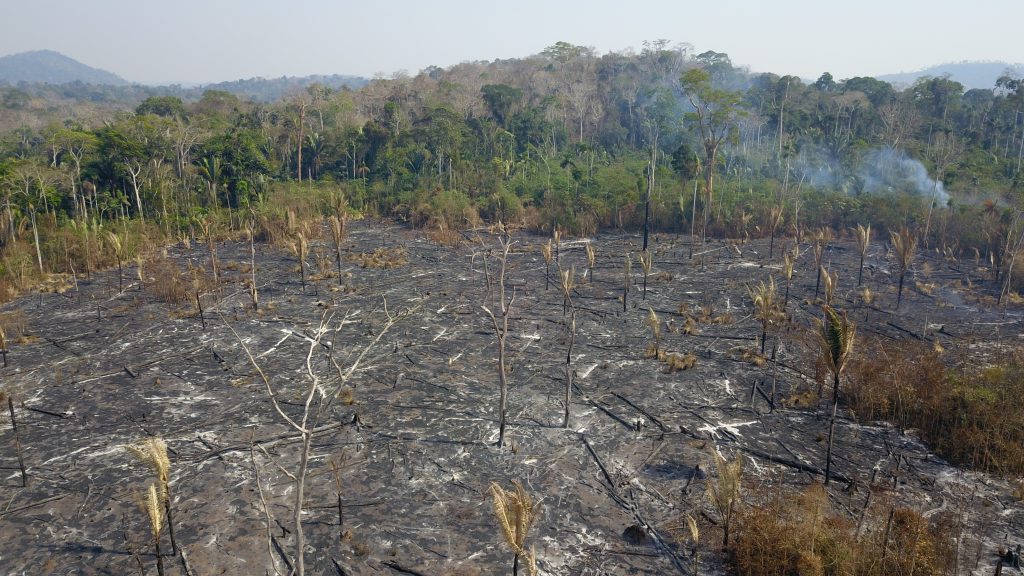
Photo courtesy of Diogo Barbalho Hungria.
I’m back home after 10 days in Brazil. Because of the fires that have been burning across the Amazon basin, it became a different trip than I had planned. I went there with Zeb Hogan to do research for the book we’re writing about the world’s largest freshwater fish. The plan was to meet up with a Brazilian fish researcher, Lisiane Hahn, and her team and travel down the Madeira River, an Amazon tributary, to learn more about migrations of big fish. We were still able to do that, but the fire story ended up consuming much of our time and attention.
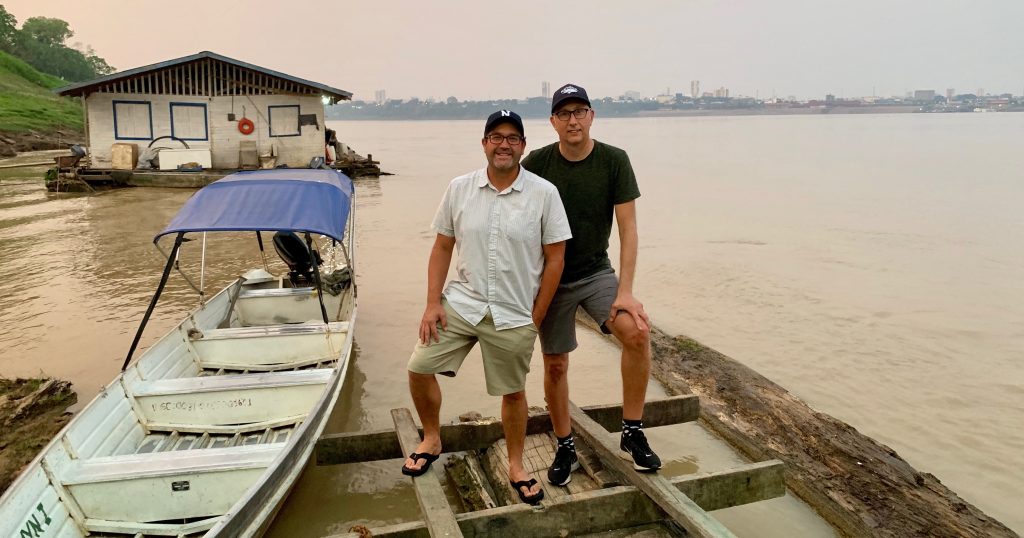
International reporting on the fires had just ignited when I left for Brazil. Before taking off, I saw TV images of a blacked-out Sao Paulo. When I got there after an overnight flight from Germany, the air had cleared. From Sao Paulo, I flew to Cuiabá and from there to Porto Velho, where we were meeting up with the researchers.
Porto Velho is the administrative capital of Rondônia state in western Brazil. It borders Bolivia and is known as cattle country. The state was once home to more than 50 million acres of rainforest, but satellite images suggest that at least a third of that is now gone, most of it cleared to make room for cattle grazing.
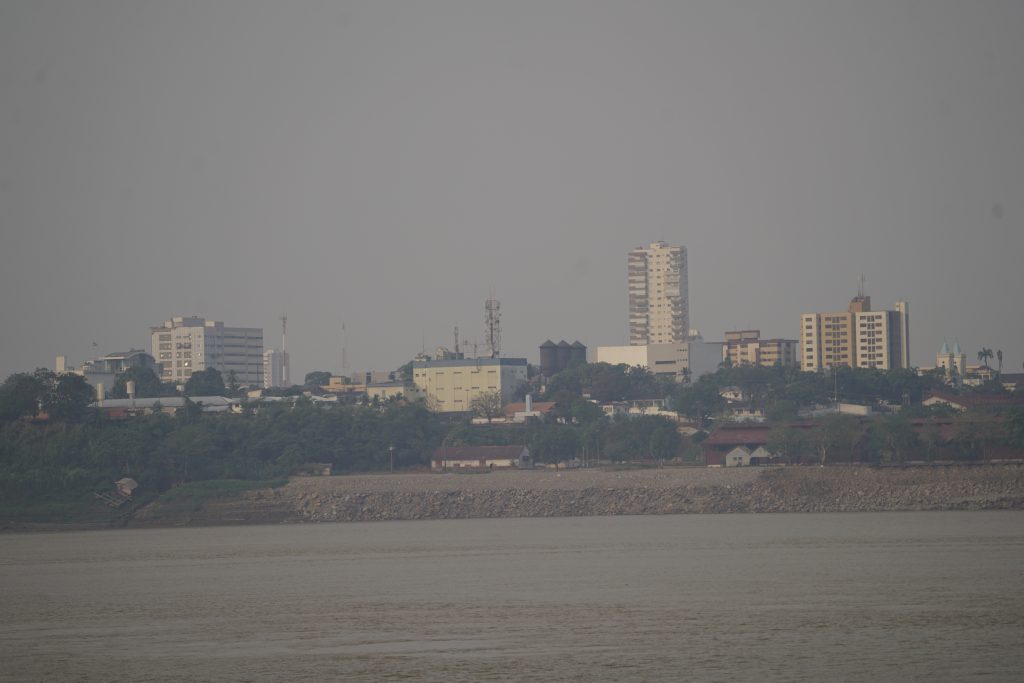
My flight arrived in the afternoon. From my aisle seat, I couldn’t see any of the ground before we had already landed. The smoke was palpable as soon as we stepped off the plane, though it didn’t sting my nostrils the way smoke from other fires I’ve been near have done. Lisi and her biologist colleagues, two guys both named Leonardo, met me at the arrivals hall and we got into a car. Across the road from the terminal, the entire landscape had been burnt to a crisp. I was told the airport had been closed a couple of days earlier with the fire coming scarily close to a fuel depot.
Porto Velho has a population of more than 400,000 and sits along the Madeira River. Much of the city looks somewhat seedy with a lot of storefronts boarded up. I don’t think I’ve ever seen a city of that size without a promenade along the river or even access to it. As we drove though the city to a shopping mall to get some lunch, there were no signs of the fires, except for the hazy air. I didn’t see any people wearing face masks or any protection. “They’re used to the fires this time of year,” said Lisi, who lives in a small town in southern Brazil, next to Uruguay, where there is no big forest to burn. None of the papers at the newspaper stand inside the mall appeared to have the fire story on their front pages.
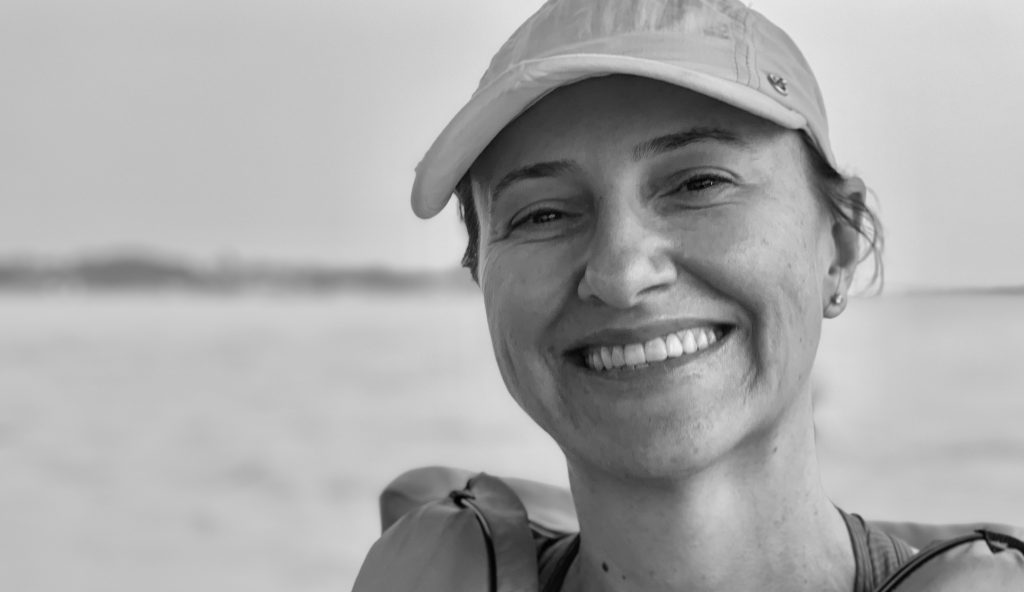
Later in the evening, Zeb arrived and we checked into our hotel. The plan was to leave the following day, but the boat — a two-story vessel belonging to Lisi’s consulting company that was supposed to pick us up in Porto Velho — had got stuck somewhere downstream because of poor visibility. The captain had made the decision to stay where they were for fear of running into other traffic or any of the large sandbanks that get exposed during the dry season as the river level drops dramatically. They’d finally been able to go on, but now the ship’s engine had broken down. It looked like our departure would be delayed by at least a day.
That was fine by me, because the next morning I got a message from National Geographic asking me if I could file a text and video story on the fires. The Amazon fires now topped much of the international news coverage, including at National Geographic, which had put up a story written out of Washington the previous day. They wanted me to do a piece on what things looked like on the ground, and asked if I could turn it around in a day. I said I could.
It’s been a while since I’ve done straight news reporting, and it was exciting to get back to it, doing interviews on the street and so on. Lisi set up an interview with a researcher she knew in Porto Velho. as we were about to head over to his office, however, the guy called to cancel the interview. Apparently he had given a radio interview the night before, which the people who fund his research did not approve of. They had told him in no uncertain terms: no more interviews if he wanted to keep his funding. The guy apologized profusely. He did, however, provide the phone number of an NGO working for the rights of indigenous communities whose founder he said would be willing to talk to me.
The fires is a politically sensitive story in Brazil. The dramatic increase in the number of fires being set this year is a direct result of the Brazilian government — under “Trump President” Jair Bolsonaro — signaling to ranchers and loggers that it’s ok to go ahead and burn more land, and that they don’t have to worry about breaking the law or being fined. Even before taking office at the beginning of the year, Bolsonaro vowed to do away with what he calls the “fine industry” in Brazil, and since then he has stripped IBAMA, the agency that enforces environmental laws in Brazil, of funding and support. Data released the day after I arrived showed an increase in fires of 190% in Rondônia state this year compared to last.
I heard an interesting statistic: Of the five Amazonian states with the highest increase in fires, four are governed by people in Bolsonaro‘s current or recent political parties. By contrast, the two states registering a decrease in fire incidence are governed by Bolsonaro’s political enemies. Meanwhile, some of those who are speaking out against what’s happening have been silenced. A month ago, the head of the Brazilian space agency was fired after he reported an 88% increase in the deforestation rate in Brazil.
The group working for the rights of indigenous people that I went to see is called Kanindé, and I interviewed its founder, Ivaneide Bandeira Cardoso. She is an older woman committed to the good fight despite receiving plenty of death threats. While I was in her office, she fielded numerous phone calls from international media, including the BBC, The Guardian and The New York Times. She spoke eloquently of the injustices suffered by Brazil’s one million indigenous people and how the fires could destroy their very existence. She called the land invaders criminals. I was happy when National Geographic built the video story around her testimony. You can watch the video here.
And here is the first text story that I did.
I shot some video of land that had been burnt around Porto Velho, including the area around the airport. We could see scattered plumes of smoke rising from outside the city limits, but it wasn’t necessary to go there to film it. Instead I made arrangements to get drone footage of fires from a colleague of the Leonardos. I knew there was aerial footage from the big news agencies that Nat Geo could use, too.
My stories generated a lot of attention, with views many times higher than what my usual Nat Geo stories attract. Some of the ordinary Brazilians I met wondered why there was so much international interest in the Amazon. I said I wasn’t sure, but that many people recognize the environmental importance that the Amazon plays globally, how the fate of the Amazon is seen as linked to the fate of the planet. While the idea of the Amazon as the lungs of the Earth is a misnomer — the world would not run out of air to breathe even if the Amazon was completely destroyed along with all living biomass, as explained here — the Amazon rainforest does hold the equivalent of 10 years’ worth of global greenhouse gas emissions and therefore functions as a vital carbon sink to stem the effects of climate change, and I do think that’s something that reasonable people around the world understand.
Maybe it’s just that the rainforest, the largest on Earth, is so beautiful and so amazing in many different ways ways. It is the most biodiverse environment on the planet, though it does not house that one iconic species that can make people rally to the cause of protecting some place. Imagine the news coverage if there were pandas rather than 3,000 species (and counting) of fish in the Amazon! Most people think of the Amazon as one giant, green carpet, which is not at all accurate but does make it easier to visualize the image of the Amazonian jungle disappearing at the rate of three football fields a minute. That’s a picture that gets a lot of people upset. Some scientists warn that the Amazon may be nearing a “tipping point” with the region so degraded that even a small uptick in deforestation could transform the forest into something resembling woodland savanna. So there’s urgency involved, too.
After a few days of my arriving in Porto Velho, the local news coverage of the fires had ramped up considerably. The story was on Brazilian TV constantly, and in the hotel restaurant and other places people gathered in front of the TV screens to watch. It seemed like the international coverage had had a boomerang effect on the Brazilian media, which is something I’ve rarely seen with other stories. My impression is that Brazilians, like most people in the world, care very deeply about what the outside world thinks of them, and the international coverage of the Amazon fires did not paint a positive picture of the country. I heard a lot of people worried about potential economic repercussions for Brazil in the form of canceled trade deals and so on. Many were embarrassed by their president’s macho style.
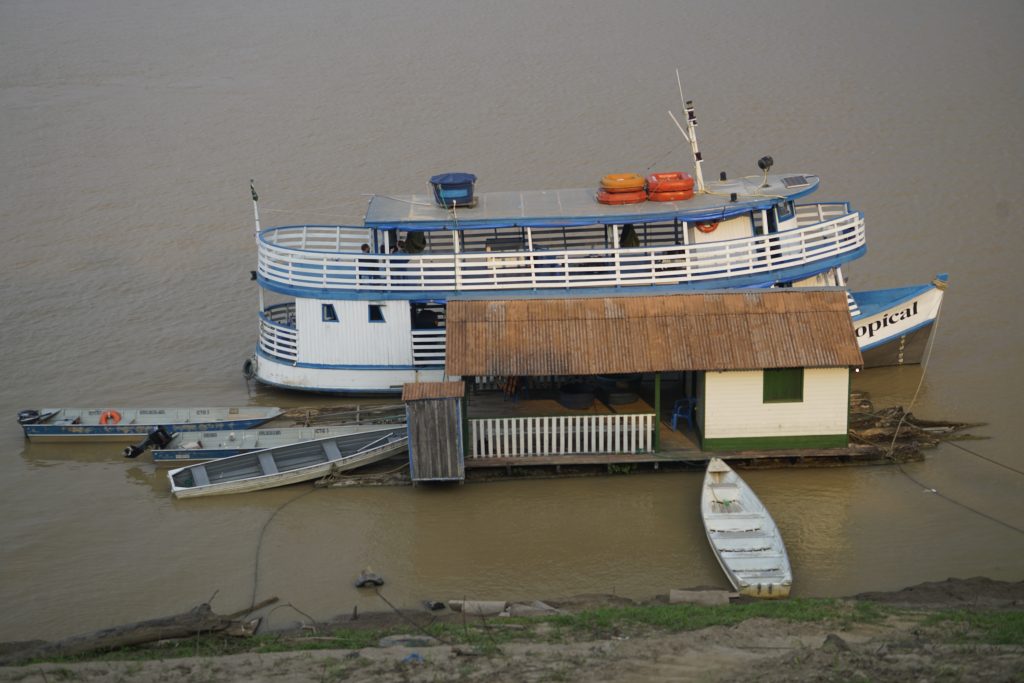
On Saturday afternoon, the boat was finally ready to go. But it was late and we decided to leave for our expedition the following day. Instead we took a small boat and traveled a short distance up the Madeira River to just below the Santo Antônio Dam, which was constructed near Porto Velho at a cost of US $7 billion and opened in 2012. I’ve written a lot about hydropower and dams lately. (You can read about it here and here and here.) Many people see hydropower as a form of green energy, which is wrong. When a dam is put in, the free-flowing river suddenly becomes a stagnant reservoir, the natural habitat disappears, and with it the fish. Water in reservoirs created by dams is made warmer, too, because it’s not flowing as freely, so it can actually exacerbate climate change.
Dam operators around the world are often secretive and won’t let people like me come near their installations. In fact, we had been denied permission to visit Jirau dam further upstream. (I’ve never understood why businesses such as hydropower companies or those in extractive industries always seem to believe it’s in their best interest to not accommodate or engage with journalists.) At Santo Antônio, I was able to get some good drone footage of the dam, though I almost dumped the drone into the water as it was difficult to force it to return to our drifiting boat. I’m still learning to fly it.
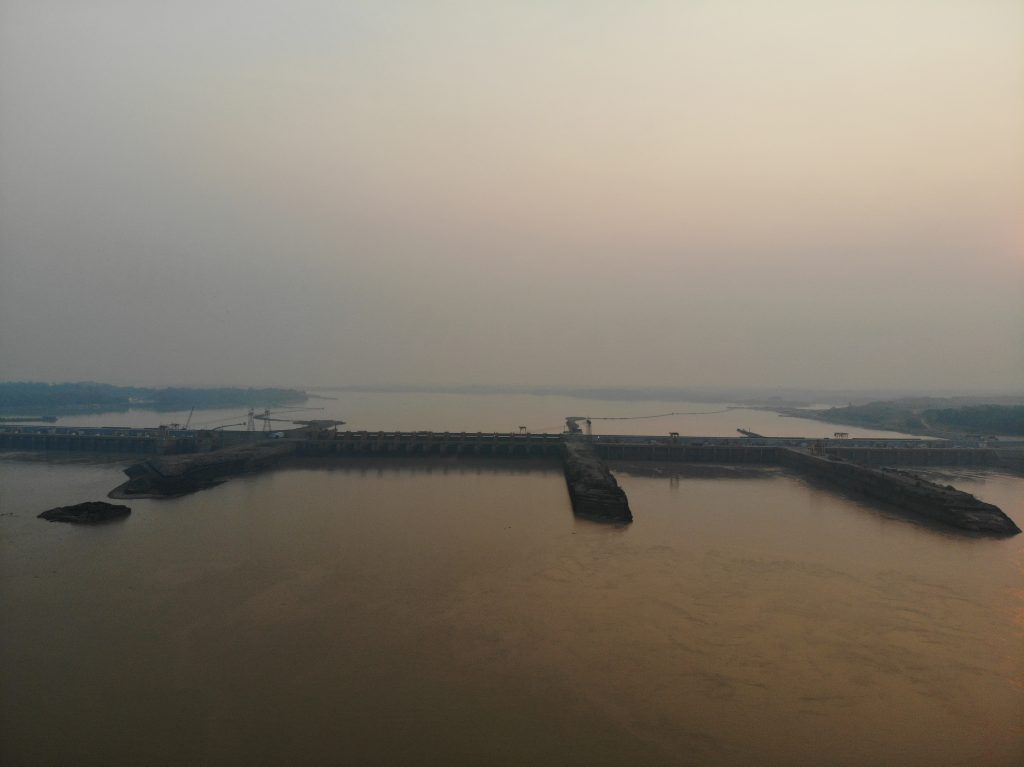
On Sunday morning, we set off down the Madeira River. Our plan was to get to the Machado River (also known as Ji-Paraná), which runs into the Madeira a few hundred kilometers downstream. The Machado river plays an important role for migratory fish, as Lisi and her team have established. On the day before we left, however, the Amazonian newspaper reported that the Bolsonaro government had announced that it would push ahead with plans to dam a series of rivers, including the Machado. It would have devastating consequences for the fish in the river.
Migratory fish are the biggest victims of dams, which block their migration routes for spawning and feeding. Nowhere in the world do fish travel as far as they do in the Amazon. Lisi and her team have tagged more than 2,000 fish to track their movement, which may be most for any study in the tropics. Lisi and others have shown that the dorado catfish, which can grow up to two meters long, will travel up to 11,600 km, from the Andes to the mouth of the Amazon and back, in order to feed and spawn, making it the longest freshwater fish migration in the world.
From the river, the forest seemed almost completely intact. But when we stopped to fly the drone inland, we could see that in many places only a narrow strip of forest remained next to the shoreline while large tracts of land had been deforested just a couple of hundred meters in. Every now and then we would see huge plumes of smoke, though we never saw any flames. The visibility was for the most part pretty bad, especially in the mornings, since fires are often set late in the day and allowed to burn overnight. We never saw any efforts to extinguish them, and why would we? These fires were intentionally set because people wanted to burn that land.
I came up with an idea of doing a story about forest and fish, tied to the fires. It’s something that I don’t think the reporting on the fires has covered. The Amazon is a very good example of the strong symbiosis between forest and fish, with many fish species feeding on fruits and seeds of the forest during the wet season when the rivers flood large portions of the land. Studies have shown a strong link between deforestation and reduced fish catches. Tropical deforestation isn’t just an issue that affects climate change or terrestrial biodiversity, but also life in the river and the river in turn sustains the life of the forest. Cool stuff.
During our journey, we saw a lot of floats on the river where operators were mining for gold. I got to go on board one of them. (The cook on board our boat had worked at this mining float before and knew the people there, otherwise they wouldn’t have let me film them.) It didn’t seem like the location where the float had stopped to dig was particularly productive. The chief operator on the float showed me a few specks of gold that had been extracted from the tons of sand that had been pulled up from the bottom of the river and run through the heavy machinery. Soon the float would move on, leaving an underwater mountain of sand behind.
We reached the Machado River late on Monday afternoon. The waters were too shallow for our big boat to enter, so we got into one of the small boats and ventured up the river. It was a beautiful spot with huge, undulating sand banks that looked like tropical beaches. The light was fantastic for about an hours, until a major thunderstorm swept in and began dumping rain. We took shelter at a large, abandoned house boat that at one time seemed to have served as a restaurant.
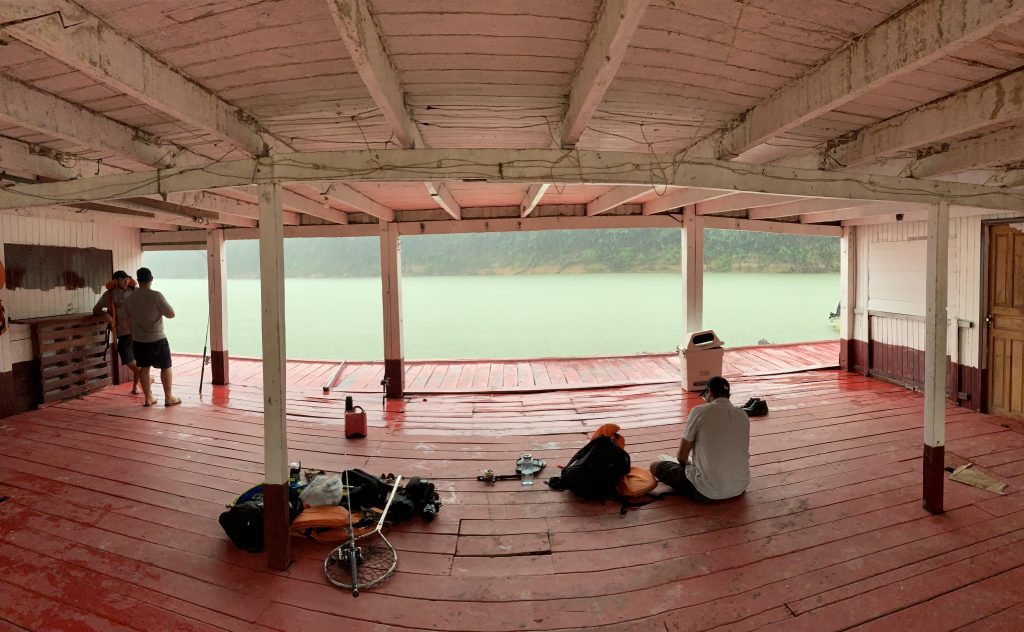
The next morning we reached Humaitá, one of the small towns situated along the Madeira River. As both Zeb and I were flying out of Porto Velho later that night, we were not going to have time to travel back by boat. Instead Lisi had sent for her company car to take us and her back to Porto Velho. We said goodbye to the Leonardos and the crew. Zeb took a cute photo.
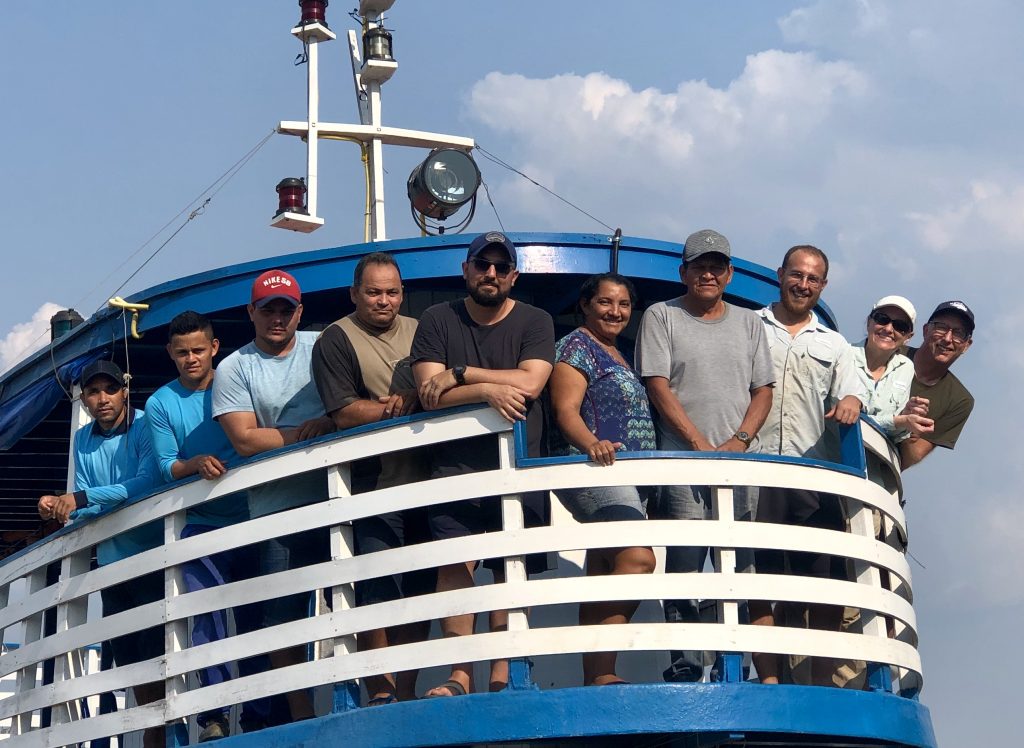
Much of the land along the highway back to Porto Velho had been cleared for agriculture and cattle grazing. It showed the close connection between humans and the loss of forest. I know the Amazon forest burns naturally, too, but it’s not what I saw. We stopped at a spot where the land had been cleared to plant eucalyptus trees, which are used to make medicine but are not native to the Amazon. They are much more commercially viable than most Amazon trees. since you can plant a lot of them in a small area and they grow quickly. Eucalyptus can also be used for furniture. I know IKEA makes stuff with eucalyptus wood, though I don’t know where they get it from. Standing on a road separating the burnt land from pristine rain forest, I took a selfie. It was striking to hear the hum of the jungle on the one side and nothing on the other.
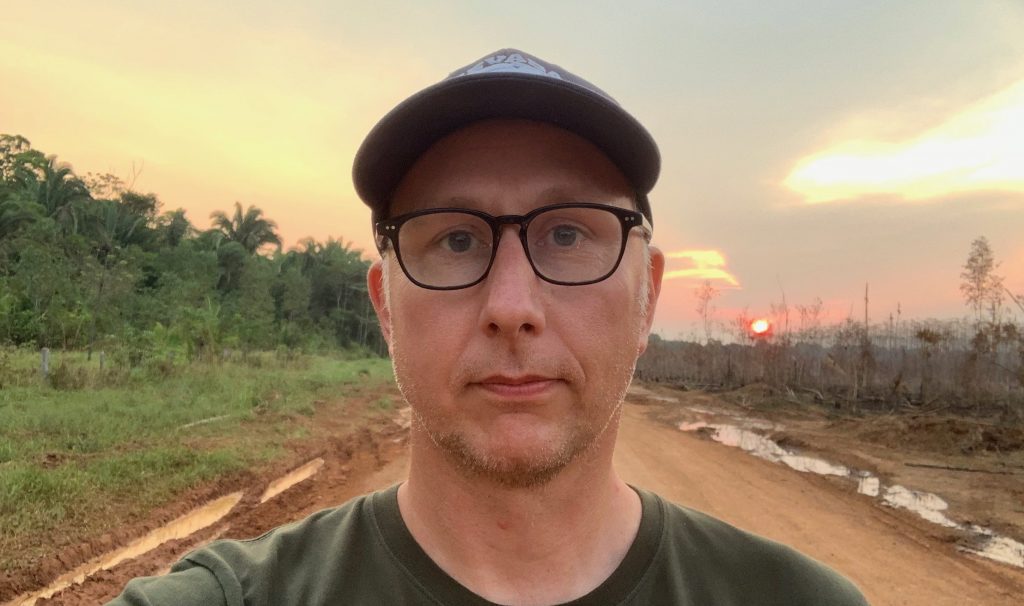
From Porto Velho, we all went our separate ways. Lisi flew back to her home town in southern Brazil, while Zeb went back to the U.S. I flew to Manaus where I spent a day doing reporting and interviewing an expert for the fish and forest story. On the flight from Manaus to Sao Paulo, which took over four hours — Brazil is enormous! — all I could see below me was smoke. Eventually the fires will die down, though I’m sure that next year they will be set again. But maybe they won’t be as bad? Maybe the outrage over them this year will make a difference? I hope so.
